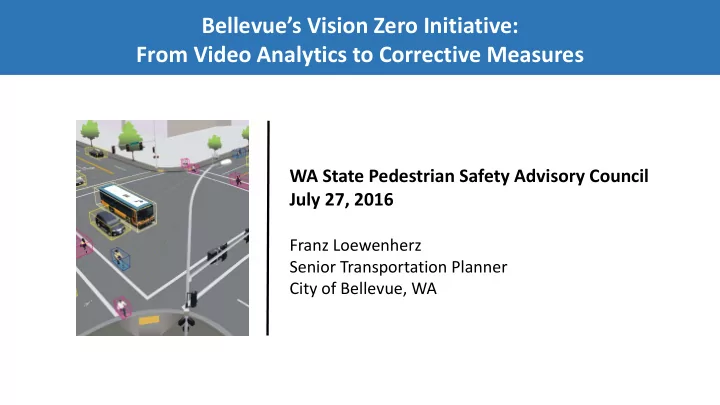

Bellevue’s Vision Zero Initiative: From Video Analytics to Corrective Measures WA State Pedestrian Safety Advisory Council July 27, 2016 Franz Loewenherz Senior Transportation Planner City of Bellevue, WA
Bellevue’s Vision Zero Initiative: Why? 2
Bellevue’s Vision Zero Initiative: Dialogue with the Public Making Vision Zero a reality entails more than just engineering, education, and enforcement. It’s a collaborative effort involving Bellevue residents and businesses. Amy Carlson, Vice President and Area Office Manager, CH2M HILL 3
Vision Zero: Reframing Traffic Deaths & Injuries as Preventable Proactive: Reactive: Reacting Preventing to a problem after problems before it arises. they arise. 4
Crash-Based Approach: Lakemont Interchange Case Study From 2005 through 2010 there were 60 In 2013, WSDOT built a new roundabout collisions recorded by the Bellevue Police at the intersection of the WB I-90 on- and Department and the WSP at this location. off-ramps and WLSP SE/180 Ave SE. 5
Crash-Based Approach: Short-Comings 1. Crashes are rare events and are therefore associated with the random variation inherent in small numbers. 2. Not all crashes are reported and the level of reporting is unevenly distributed with regard to the type of road users involved, location, severity of injuries, etc. 3. The behavioral or situational aspects of the events are not covered by police crash data. 4. Many years of crash data is typically required to develop an understanding of the situation. 6
Conflict- Based Approach: Don’t Wait For Crashes to Happen Hyden’s Safety Pyramid (adapted from Hyden, 1987) 7
Conflict-Based Approach: Public Involvement Strategy Total Points Placed Ped Facilities 514 32% Bike Facilities 573 35% Ped Behaviors 57 4% Bike Behaviors 22 1% Car Behaviors 452 28% Total 1618 8
Technology Development Partnership Exploring potential to leverage a city’s Dr. Victor Bahl existing traffic camera system to Director Mobility & Networking Research simultaneously: monitor counts and travel speed of all road user groups (vehicle, pedestrian, and Dr. Yinhai Wang bicycle); Director PacTrans and STAR Lab document the directional volume of all road user groups as they move through an intersection; and, Franz Loewenherz assess unsafe “near - miss” trajectories and Senior Transportation Planner interactions between all road user groups. 9
Partnership Approach Milestone 1: Demonstrate the capability of vision technologies by detecting relevant events in the sample traffic videos (e.g., detecting cars, pedestrians, and bikes and tracking their movements). Milestone 2: Demonstrate an end-to-end system that will, continuously in real-time, detect and store the events, and present aggregated information. Milestone 3: Pilot deployment of end-to-end system (running on servers provided by Microsoft) in the City of Bellevue traffic control center. The system will run off of a live feed. Milestone 4: Support additional scenarios (e.g., near-collisions of cars with pedestrians and bikes or patterns of bikers crossing a busy intersection). 10
How A Deep Neural Network Sees 11
Demo of System 12
Object Classification Accuracy We recognized it as… 0.67 Classified-as Vehicles Bikes Peds None Truth When it really is… Vehicles 0.01 0.02 0.02 0.95 0.73 Bikes 0.08 0.16 0.08 0.66 Peds 0.15 0.15 0.05 0.65 None 0.09 0.03 0.11 0.75 0.81 13
Literature Review: Classifying Near-Miss Events Time to Collision (Matsui et al., 2013) Swedish Conflict Technique (Hyden et. al., 1987) Post Encroachment Time (Van der Horst et. al., 2014) 14
Object Detection 15
Trajectory Detection & Turning Movement Counts 16
Vehicle Distribution Charts 17
Near-Miss Detection 18
Potential Research Questions 1. How often are vehicles speeding and failing to yield to pedestrians? 2. How often do pedestrians disregard traffic signals? 3. How often do bicyclists fail to stop at stop signs or run red lights? 4. Are there any identifiable trends that hint at the reasons why certain laws are broken in certain places? 5. Did a countermeasure have the desired effect? 8
Opportunity for USDOT Partnership? 1. Take a Complete Streets approach 2. Identify and address barriers to make streets safe and convenient for all road users, including people of all ages and abilities and those using assistive mobility devices 3. Gather and track biking and walking data 4. Use designs that are appropriate to the context of the street and its uses 5. Take advantage of opportunities to create and complete pedestrian and bicycle networks through maintenance 6. Improve walking and biking safety laws and regulations 7. Educate and enforce proper road use behavior by all 19
Safer People, Safer Streets: City of Bellevue 20
Does Bicycle Usage Increase? Source: Portland State University, Lessons from the Green Lanes: Evaluating Protected Bike Lanes, 2014. 21
Does the Conflict Rate Decrease? Where: A = Average number of conflicts at the study location per year V = Intersection ADT (total daily approach volume) 22
Funding Requirement Virtual Server Storage ~ $260K Avigilon License Groups 360 HD Cameras Camera Installation 23
Bellevue’s Vision Zero Initiative: For More Information From Video Analytics to Corrective Measures Franz Loewenherz Transportation Department floewenherz@bellevuewa.gov 425‐452‐4077 24
Recommend
More recommend